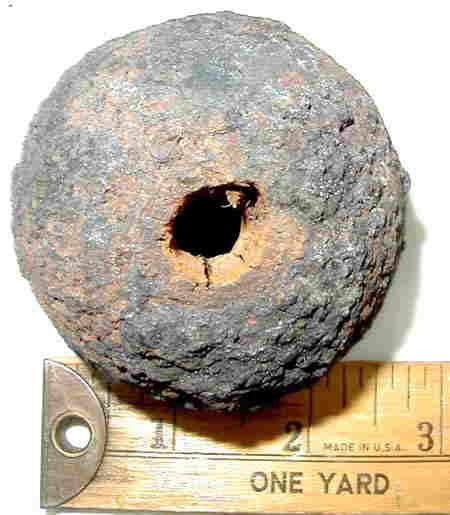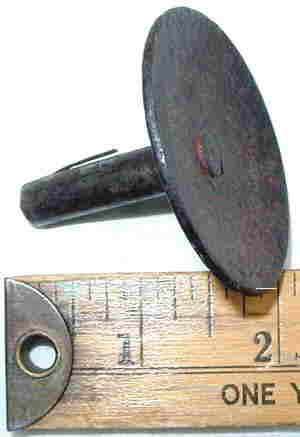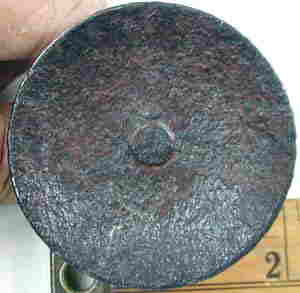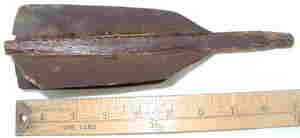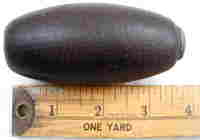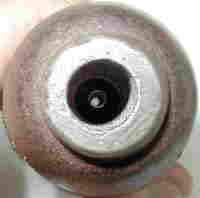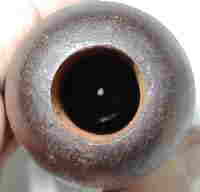|
(Cannon Ball, that is!)
(Grenade, I say!) |
||||
|
Bottom: A 2-1/2" C.S. Selma Arsenal Grenade - Inventor unknown. |
||||
|
"Billy Yank" and "Johnny Reb" got into a cannon ball "game" in 1861 that lasted for 4 terrible years. Several hundred thousand cannon balls were "thrown" from cannon during that time. Anybody who "caught" one usually lost, or at best, was put on the injured reserve list for a lengthy spell. |
||||
|
There were other projectiles that did not require a cannon or gun
to be thrown. These small explosive devices were hand held and hand
thrown, and at times, they were literally played catch with. They
were called "grenades" and were used by troops both within and without
fortifications and from boat/ship to ship/boat. The throwers sometimes
saw the same projectiles they had just lobbed at the other guy coming
right back at them...and exploding!
|
||||
|
|
||||
|
|
||||
|
This 2½" spherical grenade has a opening of about ½" that has been drilled through the tapered wood fuse plug. A close look will reveal the outline of the remaining wood. The actual opening is approximately ¾".
|
||||
|
Ignition of the charge in the small round Selma Arsenal made Confederate
grenade shown above was through a paper time fuse stuck in a tapered
wood fuse plug. Lighting the fuse, prior to throwing it, had to
be problematical. The thrower had to have some means of igniting
the fuse, and things had to be relatively dry. It also had some
other drawbacks such as blowing up in one's hands if held too long
or it being thrown back by the enemy, if left sputtering too long
at their feet. They were also catchable on the fly. I have not read
or heard any stories or reports of this grenade being used, let
alone, thrown back. Per Dickey & George's "Field Artillery Projectiles
of the Civil War," spherical grenades of this type have been found
in the Alabama River at the site of the Selma Arsenal and one was
found on the site of the siege of Blackely, Alabama. Scattered reports
of other finds have also been reported.
|
||||
|
|
||||
|
|
||||
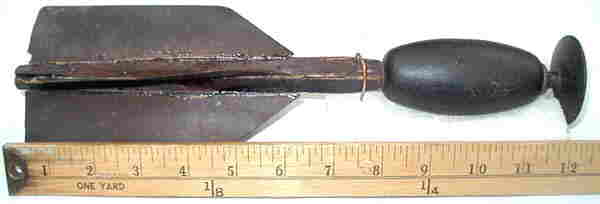
The overall measurement of this 3 piece grenade is 12¼" with the plunger and wood "tail" fully inserted.
|
||||
| The Ketchum grenade utilized a firing cap set upon a nipple within the projectile body to ignite it's charge. A slightly convex metal plunger, at the nose of the grenade, had to be depressed through the striking of something hard and solid to drive it back upon the nippled firing cap. A small pressure spring attached to the side of the plunger stem held the plunger in place during flight. The flight was stabilized by 4 thin cardboard like fins set into a wood tail-piece protruding from the rear of the projectile. The wood tail-piece also held the powder charge within the grenade in place. | ||||
|
The plunger is 1-7/8" overall. The stem is 1-7/16" with a ¾" pressure spring. |
The slightly convex plunger head has a diameter of 2" |
|||
|
The overall measurement of the tail-piece is 9" with the front 1" being necked down for insertion into the back of the casing. |
End view - each fin is 1-1/8" high and 6-3/16" long
|
|||
|
|
||||
| This was a 3 piece weapon. Plunger, casing and tail-piece. The plunger had to be removed to set the firing cap on the nipple within the casing (the setting thereof is not easily done). The wood tail-piece had to be removed to place the powder charge inside the shell and then set firmly back in to hold the powder within and to stay in place during it's trajectory path which had to have a fairly high arc to land, more or less, flush on the plunger face. | ||||
|
Read assembly instructions before using
|
||||
|
||||
|
|
||||
| The Ketchum grenade is known to have been used in Virginia, Kentucky, Louisiana and Mississippi. It was also carried on U.S. ironclads. Fort Desperate at Port Hudson was one scene where the opposing troops played catch with them. The defending Confederates picked up the initial salvo which failed to explode and threw them back at the Union attackers where they did explode. The Confederates laid blankets behind the parapet and the grenades fell harmlessly on them. They then threw them down, with some force, into the moat at the hapless Yanks gathered there. They apparently worked there but over 100 Ketchum 3 and 5 pounder grenades were recovered at Port Hudson but not one grenade fragment was found indicating that the success rate of this weapon left something to be desired. | ||||
|
It was not at all fool-proof but offered proof of a foolish design
and made fools of those who approved of its testing and use. Eventually,
as history has proved, man would get it more or less right and the
game of throwing and catching grenades would become a lot less fun.
|
||||
|
|
||||
| Thanks to my son are due again as is recognition of a reference source, FIELD ARTILLERY PROJECTILES OF THE CIVIL WAR - Revised And Supplemented 1993 Edition by THOMAS S. DICKEY AND PETER C. GEORGE. | ||||
| Every one take care. Do not play catch with any hand grenades no matter how old they may be! | ||||
|
Dave Radcliffe |
||||

